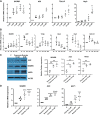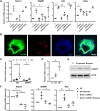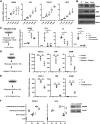Short-chain fatty acids ameliorate necrotizing enterocolitis-like intestinal injury through enhancing Notch1-mediated single immunoglobulin interleukin-1-related receptor, toll-interacting protein, and A20 induction
- PMID: 36410023
- PMCID: PMC9799135
- DOI: 10.1152/ajpgi.00057.2022
Short-chain fatty acids ameliorate necrotizing enterocolitis-like intestinal injury through enhancing Notch1-mediated single immunoglobulin interleukin-1-related receptor, toll-interacting protein, and A20 induction
Abstract
Single immunoglobulin interleukin-1-related receptor (SIGIRR), toll-interacting protein (TOLLIP), and A20 are major inhibitors of toll-like receptor (TLR) signaling induced postnatally in the neonatal intestine. Short-chain fatty acids (SCFAs), fermentation products of indigestible carbohydrates produced by symbiotic bacteria, inhibit intestinal inflammation. Herein, we investigated the mechanisms by which SCFAs regulate SIGIRR, A20, and TOLLIP expression and mitigate experimental necrotizing enterocolitis (NEC). Butyrate induced NOTCH activation by repressing sirtuin 1 (SIRT1)-mediated deacetylation of the Notch intracellular domain (NICD) in human intestinal epithelial cells (HIECs). Overexpression of NICD induced SIGIRR, A20, and TOLLIP expression. Chromatin immunoprecipitation revealed that butyrate-induced NICD binds to the SIGIRR, A20, and TOLLIP gene promoters. Notch1-shRNA suppressed butyrate-induced SIGIRR/A20 upregulation in mouse enteroids and HIEC. Flagellin (TLR5 agonist)-induced inflammation in HIEC was inhibited by butyrate in a SIGIRR-dependent manner. Neonatal mice fed butyrate had increased NICD, A20, SIGIRR, and TOLLIP expression in the ileal epithelium. Butyrate inhibited experimental NEC-induced intestinal apoptosis, cytokine expression, and histological injury. Our data suggest that SCFAs can regulate the expression of the major negative regulators of TLR signaling in the neonatal intestine through Notch1 and ameliorate experimental NEC. Enteral SCFAs supplementation in preterm infants provides a promising bacteria-free, therapeutic option for NEC.NEW & NOTEWORTHY Short-chain fatty acids (SCFAs), such as propionate and butyrate, metabolites produced by symbiotic gut bacteria are known to be anti-inflammatory, but the mechanisms by which they protect against NEC are not fully understood. In this study, we reveal that SCFAs regulate intestinal inflammation by inducing the key TLR and IL1R inhibitors, SIGIRR and A20, through activation of the pluripotent transcriptional factor NOTCH1. Butyrate-mediated SIGIRR and A20 induction represses experimental NEC in the neonatal intestine.
Keywords: Notch1; butyrate; intestinal epithelium; necrotizing enterocolitis; short-chain fatty acids.
Conflict of interest statement
No conflicts of interest, financial or otherwise, are declared by the authors.
Figures







Similar articles
-
NEC-like intestinal injury is ameliorated by Lactobacillus rhamnosus GG in parallel with SIGIRR and A20 induction in neonatal mice.Pediatr Res. 2020 Oct;88(4):546-555. doi: 10.1038/s41390-020-0797-6. Epub 2020 Feb 13. Pediatr Res. 2020. PMID: 32053825 Free PMC article.
-
SIGIRR Mutation in Human Necrotizing Enterocolitis (NEC) Disrupts STAT3-Dependent microRNA Expression in Neonatal Gut.Cell Mol Gastroenterol Hepatol. 2022;13(2):425-440. doi: 10.1016/j.jcmgh.2021.09.009. Epub 2021 Sep 23. Cell Mol Gastroenterol Hepatol. 2022. PMID: 34563711 Free PMC article.
-
Bifidobacterium adolescentis protects against necrotizing enterocolitis and upregulates TOLLIP and SIGIRR in premature neonatal rats.BMC Pediatr. 2017 Jan 5;17(1):1. doi: 10.1186/s12887-016-0759-7. BMC Pediatr. 2017. PMID: 28056921 Free PMC article.
-
Toll-Like Receptor-Mediated Intestinal Inflammatory Imbalance in the Pathogenesis of Necrotizing Enterocolitis.Cell Mol Gastroenterol Hepatol. 2018 Apr 6;6(2):229-238.e1. doi: 10.1016/j.jcmgh.2018.04.001. eCollection 2018. Cell Mol Gastroenterol Hepatol. 2018. PMID: 30105286 Free PMC article. Review.
-
Therapeutic Potential of Gut Microbiota and Its Metabolite Short-Chain Fatty Acids in Neonatal Necrotizing Enterocolitis.Life (Basel). 2023 Feb 16;13(2):561. doi: 10.3390/life13020561. Life (Basel). 2023. PMID: 36836917 Free PMC article. Review.
Cited by
-
The Detrimental Effects of Peripartum Antibiotics on Gut Proliferation and Formula Feeding Injury in Neonatal Mice Are Alleviated with Lactobacillus rhamnosus GG.Microorganisms. 2023 Jun 1;11(6):1482. doi: 10.3390/microorganisms11061482. Microorganisms. 2023. PMID: 37374984 Free PMC article.
-
Deciphering dynamic antibiotics-microbiome-metabolome interactions in preterm infants using systems biology.iScience. 2025 Jun 28;28(8):113038. doi: 10.1016/j.isci.2025.113038. eCollection 2025 Aug 15. iScience. 2025. PMID: 40703452 Free PMC article.
-
The role of mesenchymal stem cells in attenuating inflammatory bowel disease through ubiquitination.Front Immunol. 2024 Aug 9;15:1423069. doi: 10.3389/fimmu.2024.1423069. eCollection 2024. Front Immunol. 2024. PMID: 39185411 Free PMC article. Review.
-
Review: microbial metabolites - a key to address gut inflammation and barrier dysfunction in the premature infant.Gut Microbes. 2025 Dec;17(1):2551117. doi: 10.1080/19490976.2025.2551117. Epub 2025 Aug 31. Gut Microbes. 2025. PMID: 40887742 Free PMC article. Review.
-
Short-chain fatty acids-a key link between the gut microbiome and T-lymphocytes in neonates?Pediatr Res. 2025 Apr 30. doi: 10.1038/s41390-025-04075-0. Online ahead of print. Pediatr Res. 2025. PMID: 40307498 Review.
References
-
- Yu W, Haque I, Venkatraman A, Menden HL, Mabry SM, Roy BC, Xia S, Prokop JW, Umar S, Geurts AM, Sampath V. SIGIRR mutation in human necrotizing enterocolitis (NEC) disrupts STAT3-dependent microRNA expression in neonatal gut. Cell Mol Gastroenterol Hepatol 13: 425–440, 2022. doi:10.1016/J.JCMGH.2021.09.009. - DOI - PMC - PubMed
Publication types
MeSH terms
Substances
Grants and funding
LinkOut - more resources
Full Text Sources
Research Materials

